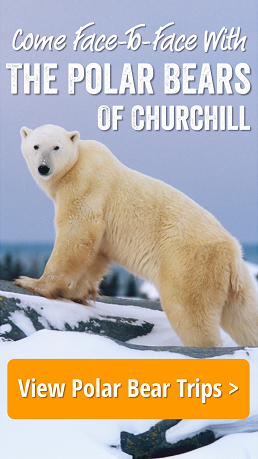by Steve Selden | May 27, 2013 | Tour News
If you havn’t spent time in Churchill, MB in the summer, you need to go. It’s an amazing, relaxing experience you will rarely find..other than say ..Alaska. The fact that even Alaska can be more accessible makes Churchill a hidden oasis in this frenetic -paced world we live in. Everything slows down in Churchill and unlike polar bear season, nobody seems to mind at all. One comes away from a summer trip to Churchill with a refreshed peace of mind.
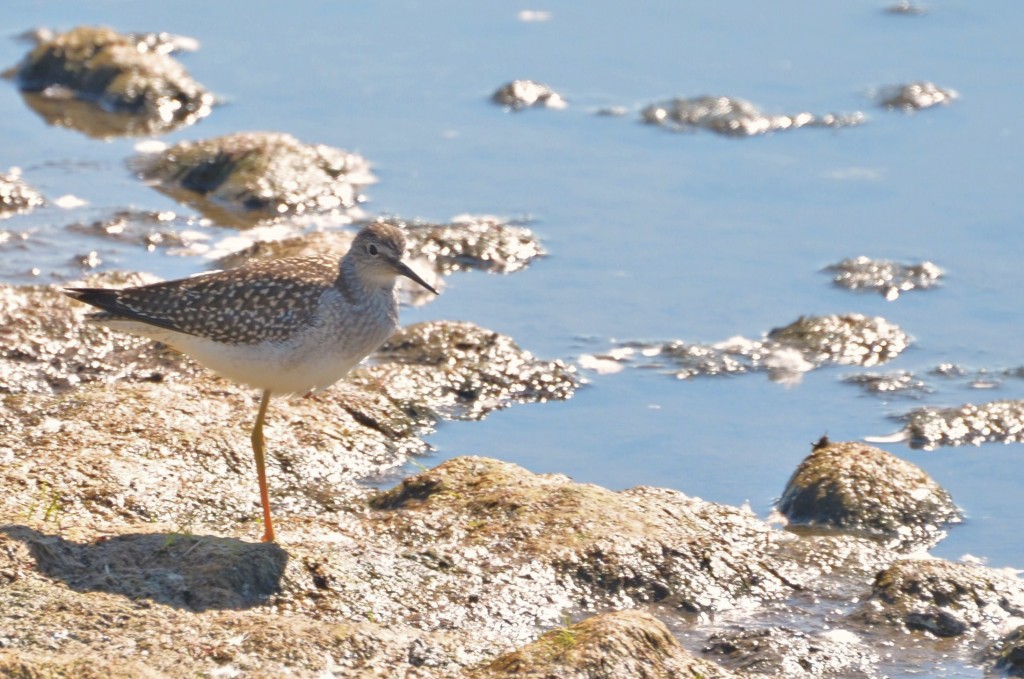
Lesser yellowlegs by the Hudson Bay coast. Sue Zajac photo.
Before the nearly 2,500 beluga whales arrive in the region, numerous species of birds make their annual migration to the rich food source that is the wetlands surrounding the Hudson Bay. Of course the one species that makes the longest sojourn being the Arctic tern …flying pole to pole in extreme conditions. The bird sees two summers each year traveling 44,300 miles annually. Now there’s some frequent flyer miles!

Arctic tern resting on a rock. Photo Gerrit Vyn.
Numerous other shorebirds as well as inland species enjoy a bountiful summer in Churchill and a majority overlap with the whale population’s arrival in the bay and surrounding rivers. Whales truly are the main character in this incredible performance of Wildlife in the Arctic. Everything else…the birds,wildflowers,tundra,coastal and boreal forest landscape. aurora borealis….and even the polar bears…are the supporting actors. beluga whales bring the essence of the north to the soul.
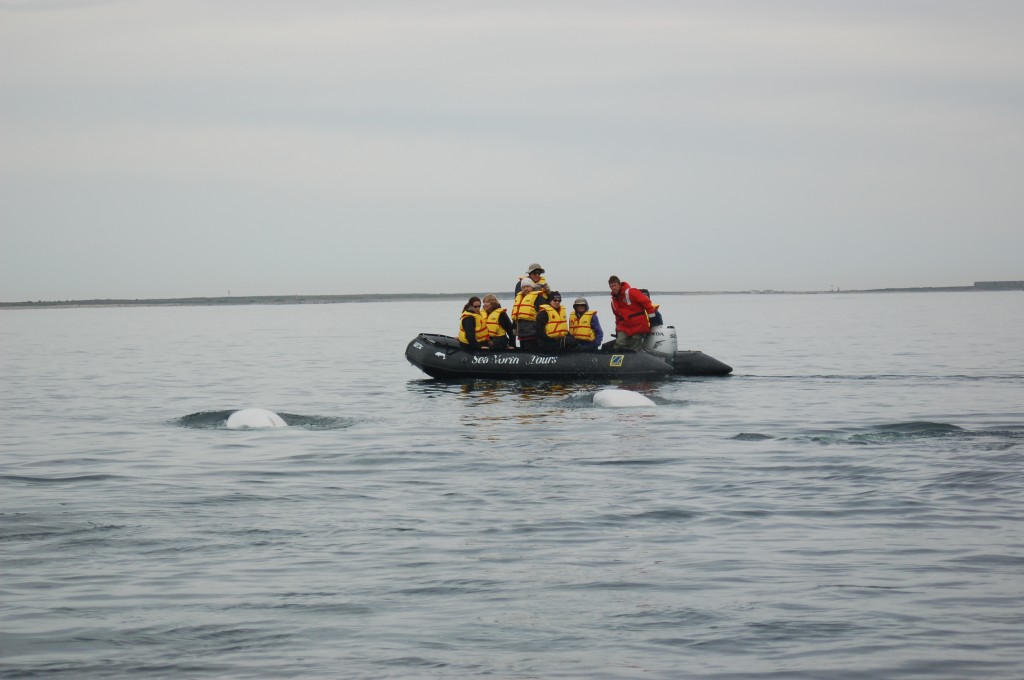
Viewing beluga whales from a zodiac. Photo Steve Selden.
No single day is the same out on the water either in the Churchill River or the Hudson Bay. Weather has a huge influence on whale behavior. Calm, placid days allow whales to fish for capelin with no effort…continuously breaking the glass-like plane of the water’s surface. Other windy,choppy days make for more erratic behavior..often making the sightings less unique. Whales stay lower in the water though the experience is just as intense…being with these magnificent creatures in the wild northern waters.

Beluga whales in the clear, cold water of the mouth of the Churchill River. Photo Steve selden
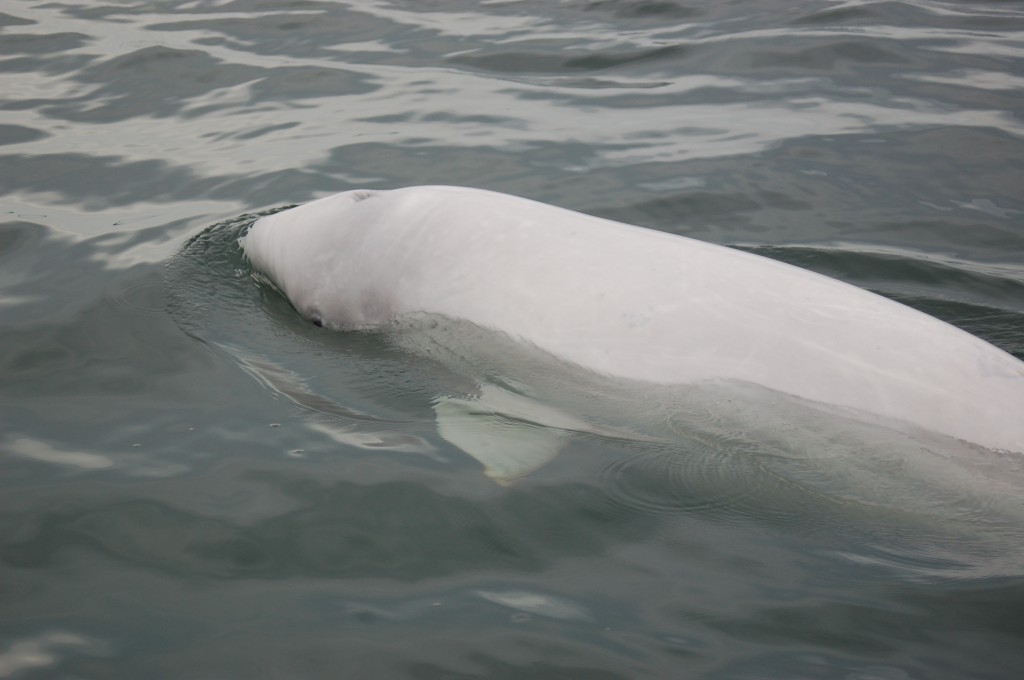
Beluga whale in the Churchill River. Steve Selden photo.
Because of heavy ice -pack in the north, beluga’s do not have a dorsal fin. Fins would be at serious risk of damage when surfacing among the ice….causing life threatening injury. Increased acuity at tail fluke maneuverability and pectoral fin movement compensate for the lack of the dorsal fin. These animals can turn on a dime and dive in the same instant..their fine sense of space and motion is rounded out by echolocation that is so fine tuned in the water. Whales are very comfortable in their surroundings.
Many more secrets are waiting for those who travel to Churchill in the summer…..find out for yourself.
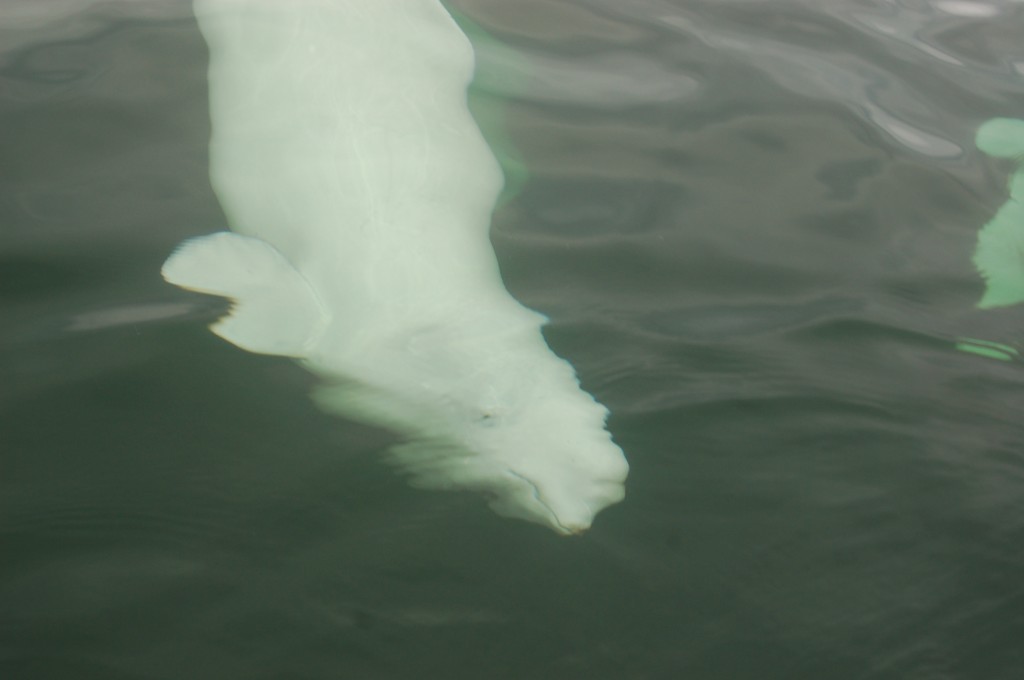
Beluga looking curiously up from the Churchill River. Steve Selden photo.
by Steve Selden | May 14, 2013 | Churchill News, Tour News
With the Arctic summer coming soon..although recent weather in Churchill does not point to that fact…I thought some of my favorite pics would be a good way to get travelers heading north in the mood. And, maybe some might even spur you on to book a spot on one of the most incredible trips in the far north.
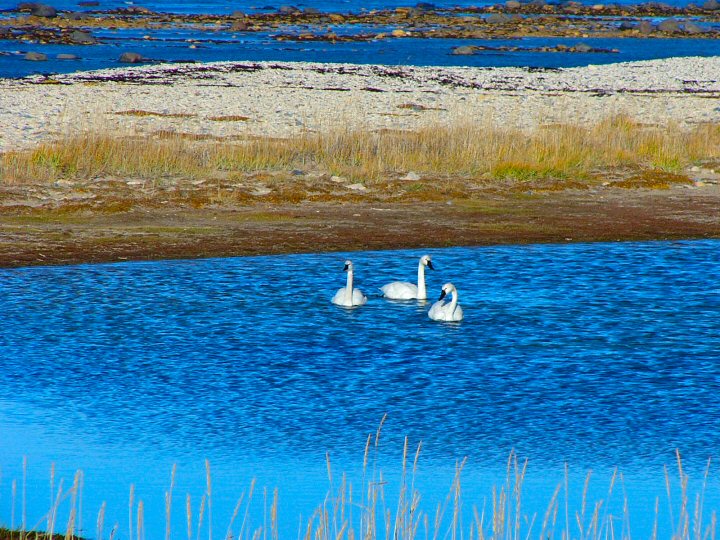
Tundra Swans on a thermakarst in the Churchill Wildlife Management area. Ed Bouvier photo.

Beluga whales rise up from the Churchill River. Steve Selden photo.
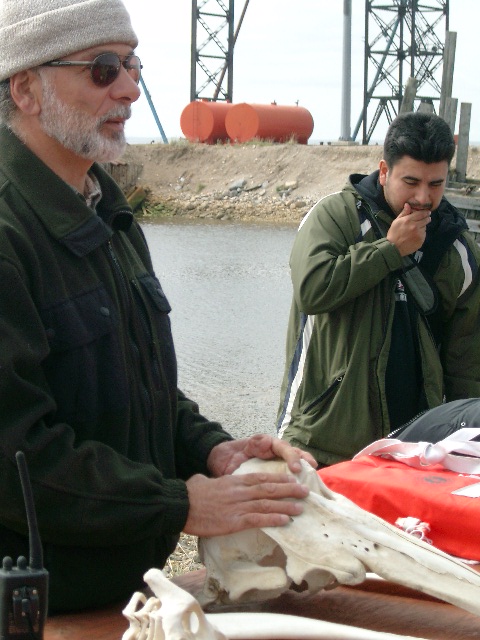
Former owner and founder of Sea North Tours, Mike Macri, educates travelers on beluga whale biology at the boat dock in Churchill,MB. Steve Selden photo.
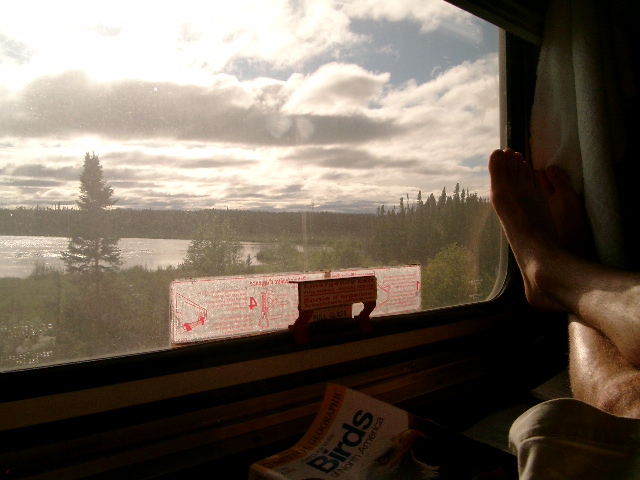
An amazing train trip to Churchill from Winnipeg on VIA Rail. Steve Selden photo.
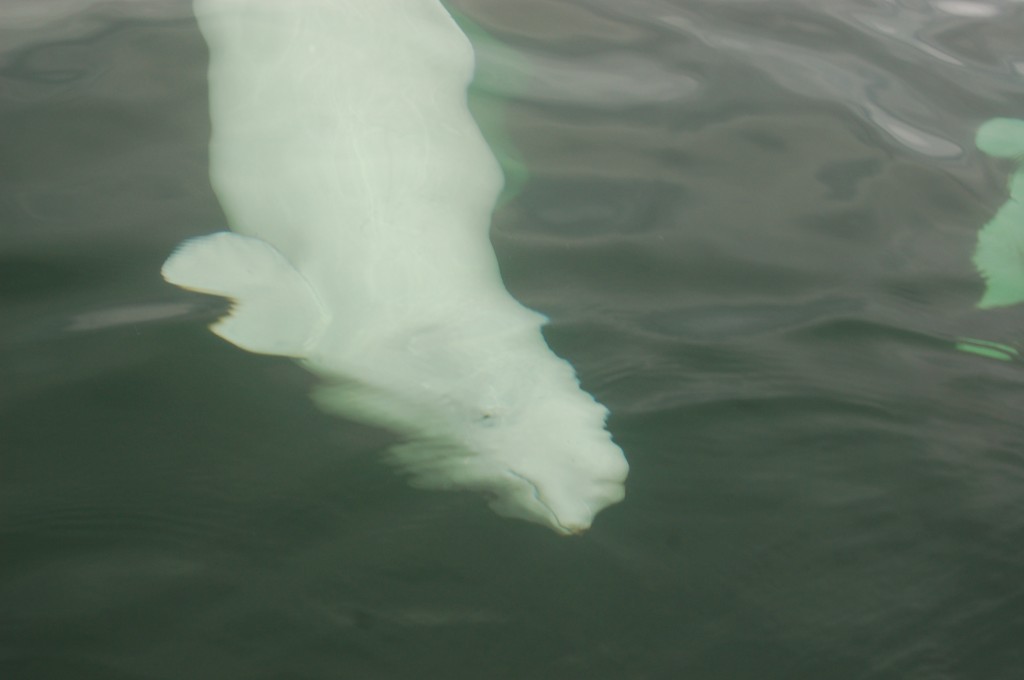
A large male beluga whale glancing up curiously at our zodiac. Steve Selden photo.
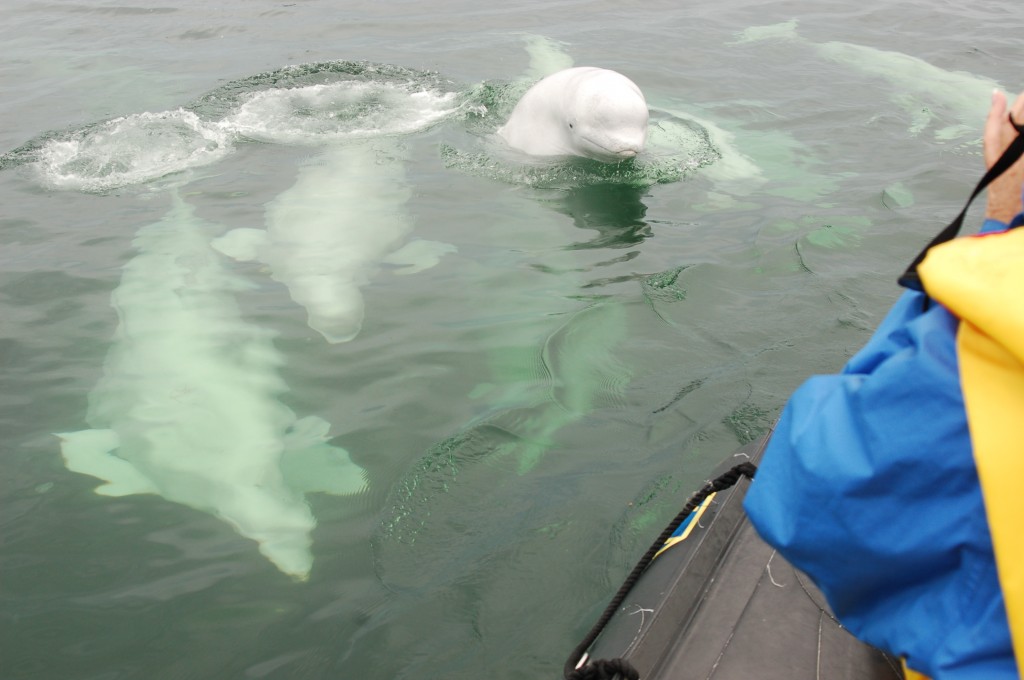
A beluga whale popping out from the Churchill River near the mouth where visibility is amazing. Steve Selden photo.
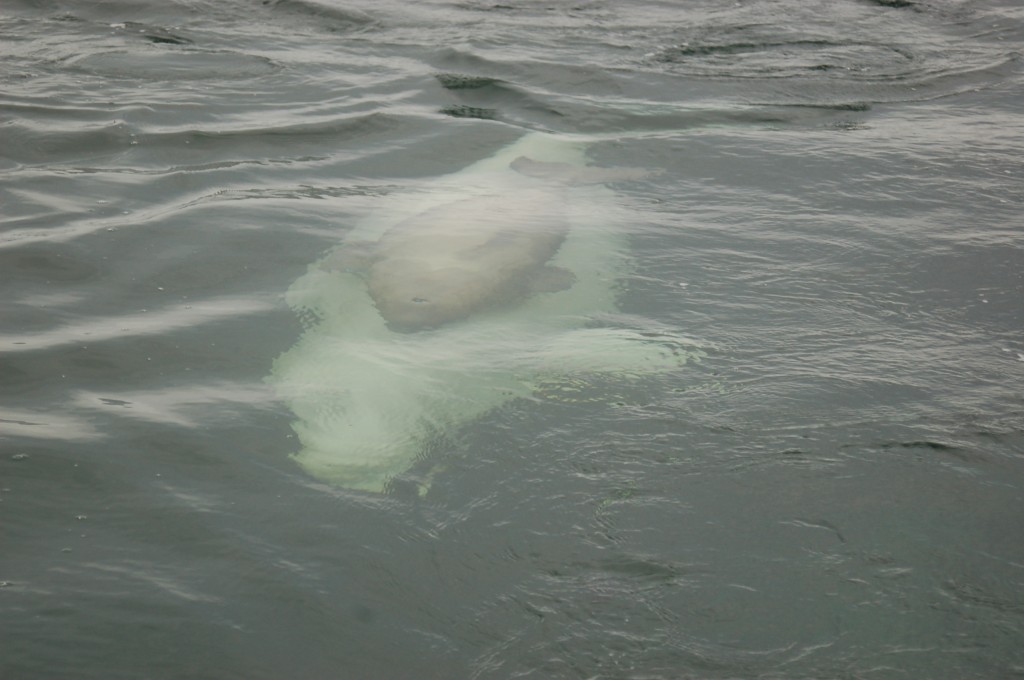
A baby calf beluga swimming in his mother’s slipstream to stay close. Steve Selden photo.
by Steve Selden | May 10, 2013 | Tour News
The greatest memories of adventure tours seem to be the ones that aren’t predictable or pre -determined by set activity schedules. They happen unexpectedly and usually involve some trepidation. With the Churchill Arctic Summer season approaching I’m reminiscing about a memorable day on the Hudson Bay coast.

Curious polar bear checking out travelers..
I had a feeling of angst that August morning years ago as we boarded the polar rover docked at the platform just outside the Great White Bear shop 20 kilometers outside Churchill, MB. After an extraordinary 38 hour train journey from Winnipeg to Churchill with a group of a dozen avid Arctic explorers, we were all anxious to get out, “on the land” as they say in the north. The rover journey to Halfway Point was one I had taken nearly a hundred times before..but this day something felt strange. The air was cool and misty fog floated from the bogs up and over the tundra toward the coast. My mind kept wandering.

Halfway Point..a view down to the beach and location of the beluga skeleton in the grass.
Our drive through the Churchill Wildlife Management Area (CWMA) was soothing as the rocking movement of the rover blended with the slight hint of salt air wafting up from the Hudson Bay to lull everyone into a calm state of mind. Although the group had spent minimal time on land the past couple of days, everyone seemed content to know that soon we would be on foot trudging over the precambrian shield rocks and incredible wildflowers and berries of various northern plants. A barbecue overlooking the Hudson Bay with a cool Summer breeze off the water to dissuade mosquitoes….life doesn’t get any better up north…unless a polar bear happens to walk by.
On board my co-guide and Ornithology expert Bonnie Chartier spotted various birds in the willows and across the landscape. Birders in the group enjoyed witnessing rare species interacting in the northern web of life. With the fog sometimes making identification difficult, the enjoyment came from just observing. The excitement was infectious to all.
We crept closer to the point overlooking the turbulent Hudson Bay. I explained that we would be hiking down through a rocky outcropping which opened onto a beach strewn with kelp. There was a skeleton from a beluga whale carcass at the far end of the beach nestled up in the sea grass. Another Natural Habitat group led by myself and long -time colleague Mike Bruscia had been lucky enough to discover it nearly a year before while exploring the beach. Now the hope was to find it again…though we would never make it that far.
Our rover driver, John Sinclair, who this story really is about, was a quiet unassuming local who did whatever he needed to provide for his family. A great guy and a friend of mine. As John maneuvered the machine into a spot up on the rise above the bay, everyone was anxious to disembark and feel the tundra under their feet. I still had a sense of hesitation but couldn’t pin point why….just a feeling.
John lowered the heavy aluminum-grated stairway and the group gathered around the rover’s enormous rear wheel for some safety rules. We headed down the gravelly road toward the beach. Usually the rover driver would stay behind on the hike to get the barbecue going for the guests return and I alone, wielding a 12 gauge shotgun filled with cracker shells and a couple of slugs would escort the group along the beach. But as I quickly realized, John was walking quietly and..well..unassuming next to me.
The mist was now a ground – fog as the group moved tentatively along and we were soon about a hundred yards from the rover. John told me, “he was going back to the rover”…well at least that’s what I thought he said. What he actually said in a tone somewhere between a whisper and a mumble was, ” I think we all should go back to the rover”. At the time I was talking with a traveler so the moment didn’t sink in as it did later. I remember looking up at John and seeing the calm in his eyes…though later on I realized it was a heightened calm that only someone who lives year – round amongst the polar bears has…someone who knows to never let his guard down when in the bear’s territory. A breeze separated the curtain of fog just enough for us to see a massive male bear about another hundred yards from us..slowly walking, as calm as John, right toward us all. We quickly signaled the rest of the group that was somewhat spread out and we all as one unit retreated intently though slowly back toward the machine waiting silently to rescue us. This was really the only time in the 12 years of guiding Summer trips I thought I might actually have to shoot a polar bear. If it wasn’t for John Sinclair’s innate sense of the land and bears I surely would have….hopefully with success.
Years later John Sinclair died in a snow mobile accident on the outskirts of Churchill in late winter. I will always remember him for his cool and relaxed personality as well as the day he possibly saved many lives. Whenever I think of him I first remember that afternoon at Halfway Point.
by Steve Selden | May 2, 2013 | Churchill News
Underlying all the “liberal” efforts out there to save this animal, that insect, this rain forest, that river is one concept we are all being quite remiss about….ourselves. So much effort and money goes toward saving all that’s worth saving on this amazing planet we dwell on…yet aren’t we really striving in some primal way to save the human race? Without all these precious puzzle pieces that make Earth “the best planet in the solar system”,….there’s the human in me coming forth…I am only human after all…, would we not all just shrivel up and blow away out into space? I believe so…these facets of life give us our meaning and soul to carry on here…indeed.
Take a look at this article that spawned these thoughts and give some feedback in comments or on our Churchill polar bears Facebook page…..very interesting!
(more…)
by Steve Selden | Apr 10, 2013 | Churchill News
11 Teams Prevail in 10th Hudson Bay Quest Dog Sled Race
Written by Tom Terry of Sioux Lookout, Ontario (Team Handler and Father to HBQ race veteran Jesse Terry)
Churchill, Manitoba — Musher Peter McClelland of Ely, Minnesota and his team of ten hardy canines were first crossing the finish line in the 10th Hudson Bay Quest dog sled race, held March 15–18, 2013, with the last of the original 15 mushers and 150 dogs arriving in Churchill, Manitoba after more than two and a half brutally challenging days on the trail from the start at Gillam.

Churchill race organizer and musher Dave Daley. Tony Loewen photo.
Strong north winds (>70 km/h) and cold temperatures (–32° C) accompanying an arctic weather system proved to be the most daunting obstacle for all teams as wind chills exceeded -54° C for almost the entire race on the open tundra. Teams found little if any opportunities for shelter either on the trail or at the various checkpoints along the way, and race veterans stated the conditions this year were the most challenging faced since a three-day blizzard forced a mid-race cancellation several years ago – that year along the route from Churchill to Arviat, NWT.

Churchill musher Charlie Lundie. Tony Loewen photo.
After slipping away from the Lamprey checkpoint, McClelland maintained an average speed of almost 11 km/h over the remaining 120 km to Churchill, including stops. A group of four teams followed two and a half hours later, regularly changing places vying for position as the end neared, but McClelland’s team kept their pace and maintained their lead to the finish.

2013 HBQ champion Peter McClelland.
Four teams made the difficult decision to withdraw at the halfway checkpoint at M’Clintock (a mandatory six hour rest with a second veterinary check of all dogs), and several teams made extended stops there and at other checkpoints. Teams withdrew for a number of reasons, all related to dog and or driver health and well-being. The fact that more than one of the drivers and teams which withdrew were Iditarod and or Yukon Quest veterans attests to the challenges faced by mushers in the Hudson Bay Quest 2013.

2013 HBQ runner-up musher Sean McCarty.
In addition to the cash purse distribution to all finishers, a number of awards were presented to mushers at the HBQ Awards Banquet held on Monday, March18th at the Churchill Town Centre Complex. Troy Groeneveld, of Minnesota, won the Churchill Northern Store Award for the First Team to Halfway Point (M’Clintock Checkpoint). The Veterinarian Award, presented to the musher selected by the Race Veterinarians as having provided the best care for their dogs, was presented to Jesse Terry, of Sioux Lookout, Ontario. The Calm Air Sportsmanship Award, along with the Red Lantern for being the last musher to successfully cross the finish line, was presented to Churchill musher Dan DiMuzio. The Award for the Best Checkpoint, selected by the mushers themselves, went to the Canadian Rangers (Churchill) manning the Lamprey checkpoint.
Final Standings:
1st Peter McClelland, White Wilderness, Ely, Minnesota (37 h, 19 m, 47 s)
2nd Shawn McCarty, White Wilderness, Ely, Minnesota (38 h, 57 m 44 s)
3rd Troy Groeneveld, 10 Squared Racing, Two Harbours, Minnesota (39 h, 01 m, 21 s)
4th David Daley, Wapusk Adventures, Churchill, Manitoba (42 h, 09 m, 30 s)
5th Matt Groth, 10 Squared Racing, Two Harbours, Minnesota (42 h, 15 m, 44 s)
6th Jesse Terry, On the Land, Sioux Lookout, Ontario (45 h, 22 m, 25 s)
7th Hank DeBruin, Winterdance, Haliburton, Ontario (45 h, 24 m, 52 s)
8th Ed The Sled Obrecht, Cayamant Kennels, Otter Lake, Quebec (49 h, 38 m, 08 s)
9th Jim Oehschleager, Ozone Sled Dogs, Newberry, Michigan (50 h, 35 m, 25 s)
10th Charlie Lundie, Charlie’s Tours, Churchill, Manitoba (54 h, 11 m, 21 s)
Red Lantern/11th Place Dan DiMuzio, Sled Dog Energy, Churchill, Manitoba (62 h, 58 m, 20 s)
Scratched: Ryan Anderson, Stefaan DeMarie, Julie Robitaille, Al Hardman.
Sponsors
The Hudson Bay Quest Race Committee and competitors are very grateful to the many sponsors and contributors, without whom this race would not be possible, including the Platinum sponsors (Calm Air International, the Canadian Rangers, The Churchill Mitigation Trust Fund, VIA Rail Canada), the Gold sponsor (Manitoba Hydro), the Silver sponsors (Aurora Inn, Churchill Chamber of commerce, Exchange Petroleum, Hudson Bay Railway, Churchill Wild, Frontiers North Adventures, Manitoba Liquor and Lotteries, Town of Churchill, Town of Gillam) and the many friends of the HBQ!



















